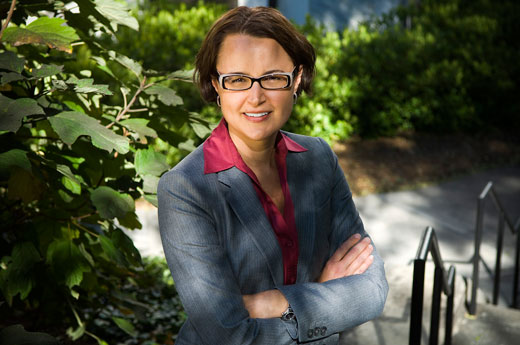It's not unusual for a University search committee to announce that it seeks a diverse pool of applicants when hiring for a position. But how is that intent best put into practice?
Is it enough to advertise job listings in the publications of diversity-minded organizations, or should the search committee reflect the very kind of diversity it hopes to find in the applicant pool?
Those are the kinds of questions being weighed by search committees across campus, says Dona Yarbrough, director of the Center for Women at Emory who is also serving a new role as associate vice provost for community and diversity.
The work of those committees is the focus of a long-range project Yarbrough is coordinating throughout Emory's schools, part of a larger plan to identify efforts to enrich faculty diversity across campus.
"My assignment is to assist the Office of Community and Diversity in enhancing faculty hiring and recruitment," Yarbrough explains.
"Our new work on faculty hiring has two basic components," she says. "One is a reporting system that is part of the new Advisory Council on Community and Diversity. Each school will report on faculty diversity in addition to other areas, such as student and staff diversity."
"From these reports we'll learn, for example, about the composition of each school's faculty, what they're doing to recruit and retain a diverse faculty, and what kinds of trainings they have related to faculty diversity."
The second component involves working with schools to provide training to search committees, especially search committee chairs, Yarbrough says.
"It really encourages them to develop plans and make progress," she adds. "We also hope to develop some best practices that schools can share with each other. "
New tools for faculty search committees
Starting with Emory College of Arts and Sciences, Yarbrough has spent months engaged in conversations about departmental search practices, with plans to extend the dialogue to other schools later this spring.
Those conversations may touch upon a range of practical topics, such as what job descriptions look like, search committee diversity, or whether objective evaluation criteria are used in hiring, she says.
It's a "two-way learning street," Yarbrough adds. "Those conversations provide an opportunity for me to share research and best practices with search committee chairs, and I learn about the challenges particular to the department or field they're hiring in."
There are plans to produce a faculty search guidebook as well as a Blackboard site. "This will allow faculty to examine research and best practices in depth," she explains.
The diversity project also fits into a bigger picture, Yarbrough adds. "One goal of the strategic plan was to have a world-class diverse faculty. Right now, our students are much more diverse than our faculty — which is similar to our peer institutions. Higher ed in general could improve a lot."
A 2008-2009 Diversity Profile prepared by Emory's Office of Community and Diversity, Employment Opportunity Programs and Institutional Research and Effectiveness indicated that:
Nearly 27 percent of all Emory faculty identified as minorities.
Women represented 36.3 percent of Emory faculty.
Just over 36 percent of all students identified as minorities.
Minority employees represented 47.6 percent of all staff.
University-wide examination of access, equity and inclusion
So far, Yarbrough reports that her campus meetings "have been received very positively."
"I think a lot of faculty are eager to bounce ideas around," she says. "It's also led to me making a connection with faculty that can be helpful if they have other challenges with community and diversity issues."
The impetus for the faculty diversity project stems back to fall 2011, when discussions were held to re-imagine community and diversity at Emory.
Last spring, conversations continued around the work of the former President's Commissions -- the President's Commission on the Status of Women, the President's Commission on Race and Ethnicity and the President's Commission on Sexuality, Gender Diversity and Queer Equality -- and the idea of a new infrastructure to sustain and develop access, equity and inclusion.
The result is the new Advisory Council on Community and Diversity, which replaces the three commissions that advised President James Wagner on diversity-related issues.
"The goal of the advisory council is not to tell units what to do but to ask them what they should be doing and to measure their success," notes Yarbrough, who co-chairs the new council.
The council's first annual review of diversity in all units of the University should take place in October, says Ozzie Harris, senior vice provost for community and diversity.
"We're making good progress," he says. "There will always be concerns about how people treat one another, how do we look at incidents that are occurring, how do we hold individuals accountable for creating workplaces where people can work and engage effectively."
"Not only are we going to talk about it, we'll find a way to produce things we say are part of our institutional values. It will allow us to think about how we target ourselves, what we prioritize and work toward," Harris adds.

